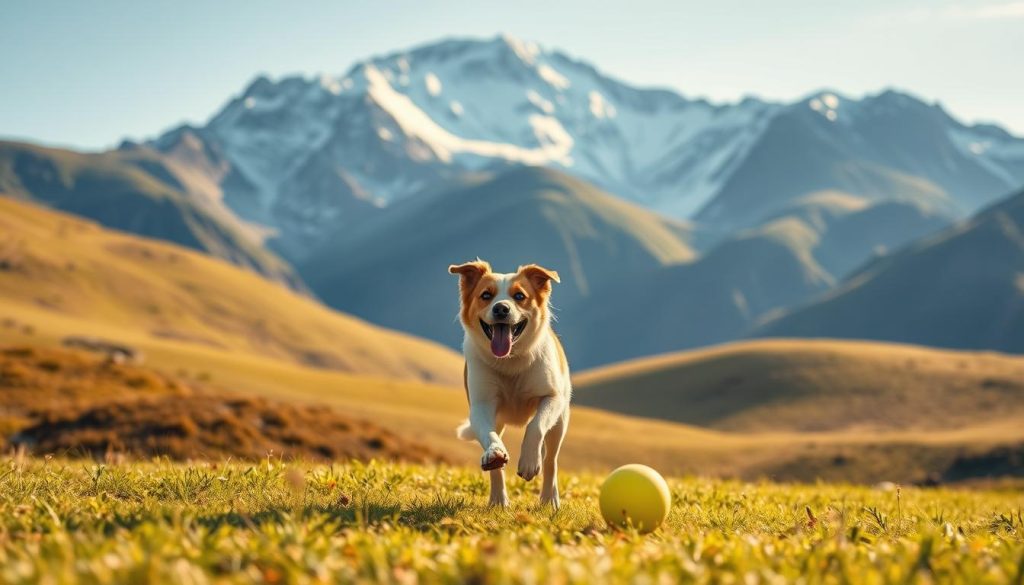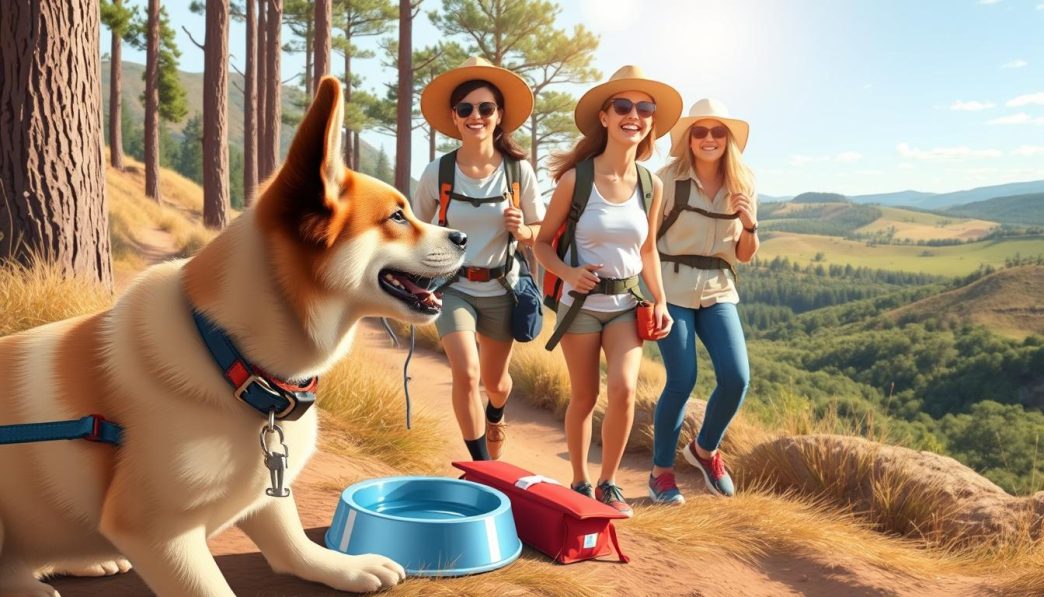When planning outdoor adventures with your furry friends, it’s key to think about their safety. The ASPCA and Leave No Trace Organization say being ready is vital for a safe and fun time.
Before you go, think about the terrain, weather, and dangers. This helps ensure pet safety. By taking the right pet safety measures, you can avoid risks and make great memories with your pets.
Key Takeaways
- Plan ahead to ensure a safe experience
- Be aware of the terrain and weather conditions
- Take necessary precautions to minimize risks
- Consider your pet’s needs and limitations
- Prepare for emergencies
The Importance of Pet Safety in the Great Outdoors
Going on outdoor adventures with your pet can be very rewarding. But, it’s key to know how to keep them safe first. Making sure your pet is safe during outdoor fun protects them and makes the experience better for both of you.
Understanding Your Pet’s Needs During Outdoor Activities
Different pets need different things for a safe outdoor trip. Some breeds are better suited for the outdoors than others. Things like age, health, and personality also matter a lot.
Before heading out, check if your pet is ready. Look at their energy, health, and how they handle different weather. This helps pick the right activities for them.
Statistics on Pet Injuries and Accidents During Outdoor Excursions
The ASPCA says many pets get hurt or lost outside each year. These numbers show why it’s vital to be ready and take safety steps.
Common dangers include injuries from wild animals, poisoning, and heatstroke. Knowing these risks helps owners keep their pets safe. This includes watching them closely and making sure they have ID.
Pre-Adventure Health Checkups and Preparations
Getting a pre-adventure health checkup is key to keeping your pet safe. It makes sure your pet is healthy and ready for outdoor fun. This can help avoid injuries and sickness.
It’s important to know what your pet needs before going out. Make sure they have all the necessary vaccinations. Also, use good ways to stop parasites.
Essential Vaccinations for Outdoor-Active Pets
Pets that love the outdoors face many diseases. Core vaccinations like rabies, distemper, and parvovirus are a must. Your vet might suggest non-core vaccinations based on your pet’s life and where you live.
Parasite Prevention Strategies
Parasites like fleas, ticks, and mosquitoes can harm your pet. Use topical treatments or oral medications to keep them away. Always check your pet for signs of parasites too.
Essential Pet Safety Measures for Outdoor Adventures
When you take your pet outside, it’s key to keep them safe. Outdoor fun is great for pets and their owners. But, there are risks that can be lessened with the right steps.
Proper Identification Methods
One important safety step is making sure your pet has ID. This can be a collar with an ID tag that shows your pet’s name and your contact info. Remember to keep this info current.
GPS Tracking Options for Pets
GPS tracking is a modern way to track your pet’s location. These devices attach to your pet’s collar and show their exact spot in real-time. Some also track activity and offer health tips.
- Real-time location tracking
- Activity monitoring
- Geofencing alerts
Microchipping: A Permanent Safety Solution
Microchipping is a permanent way to identify your pet. It’s a small chip under the skin with a unique code. This code can be scanned to find your pet if they get lost. It’s a simple way to greatly increase the chance of being reunited.
By taking these steps, you can make sure your outdoor fun with your pet is both safe and enjoyable.
Selecting the Right Gear for Pet Safety
When you take your pet outside, the right gear is key for their safety and comfort. The right equipment helps prevent injuries and makes outings fun for both you and your pet.
Protective Clothing and Footwear
Protective clothes and shoes are crucial for your pet’s safety. Get pet jackets for cold weather and booties to protect paws from hot or sharp surfaces. These are great for hiking or camping.
Appropriate Leashes, Harnesses, and Restraints
Leashes, harnesses, and restraints keep your pet safe during adventures. Choose a comfy, adjustable harness that spreads force evenly. Avoid collars that can hurt your pet’s neck. A retractable leash offers more freedom.
Portable Water and Food Solutions
It’s important to keep your pet hydrated and fed outside. Get portable water bottles or collapsible bowls for easy access to water. For longer trips, use packaged pet food that’s easy to carry and serve.
| Gear Type | Description | Benefits |
|---|---|---|
| Protective Clothing | Jackets and booties for weather and terrain protection | Prevents weather-related discomfort and injuries |
| Leashes and Harnesses | Adjustable harnesses and retractable leashes | Provides control while ensuring pet comfort |
| Portable Water and Food | Collapsible bowls and packaged pet food | Keeps pets hydrated and fed on the go |
Weather Considerations for Pet Outdoor Safety
Knowing the weather is key to keeping pets safe outside. Extreme weather can be dangerous for pets. So, pet owners need to be careful and take steps to protect them.
Hot Weather Precautions and Heat Stroke Prevention
Hot weather can lead to heat stroke in pets, a serious condition. To avoid this, limit exercise to cooler times, give lots of water, and never leave pets in cars. It’s important to know the signs of heat stroke, like heavy panting, drooling, and tiredness, to act fast.
Also, provide shade for rest and use cooling pads or vests. Keep an eye on the temperature and humidity, as high humidity increases heat stroke risk.
Cold Weather Protection Strategies
In cold weather, pets face risks of hypothermia and frostbite. Dressing your pet in the right clothes, like coats or sweaters, helps keep them warm. Keep them away from cold and give them a warm place to hide. Watch for signs of cold stress, like shivering or being very tired.
Also, feed your pet more in cold weather to help them stay warm. Make sure they always have access to water that’s not frozen.
Activity-Specific Safety Guidelines
Keeping your pet safe outdoors means knowing the risks of different activities. Each activity has its own safety steps to protect your pet.
Hiking and Trail Safety with Pets
Choose pet-friendly trails when hiking. Always keep your pet on a leash to prevent them from running off or meeting wildlife. Always carry plenty of water and snacks for both you and your pet. Watch the terrain and weather to avoid accidents. 
Camping and Overnight Excursion Precautions
Camping with pets can be great, but it needs extra care. Make sure your campsite is safe and won’t let your pet escape. Bring a portable pet bed or blanket for comfort. Always watch your pet, especially at night, to keep them safe.
Water Activities and Swimming Safety
Water activities like swimming or kayaking need careful planning. Make sure your pet is comfortable and safe in the water. Use a properly fitted life jacket for pets to keep them afloat. Always watch your pet closely to prevent accidents. Rinse them off after swimming to remove chlorine or salt.
Navigating Different Terrains Safely With Your Pet
Going outdoors with your pet requires knowing the terrain. Each place has its own dangers. Knowing these can help you stay safe.
Forest and Woodland Safety Tips
Forests and woodlands are full of sights and smells for pets. But, they also have dangers like poisonous plants and sharp objects. Always keep your pet on a leash to keep them safe.
Be careful and watch for wildlife signs. This way, you can avoid any dangers.
Beach and Shoreline Hazards
Beaches can be risky for pets because of sharp shells and hot sand. Always keep your pet on a leash. Make sure they have fresh water to stay hydrated.
Be careful of strong currents and watch for signs of tiredness. This will help keep your pet safe.
Mountain and Rocky Terrain Precautions
Mountainous and rocky areas are tricky because of steep slopes and loose gravel. Make sure your pet has the right shoes. A harness can also help.
Be ready for sudden weather changes. This will help you both stay safe.
Knowing the dangers of different places and taking steps to avoid them makes outdoor adventures better for you and your pet.
Wildlife Encounters: Keeping Your Pet Protected
Exploring the outdoors with your pet is exciting. But, it’s important to know how to keep them safe from wildlife. Adventures with your pet can be thrilling, but there are risks, especially with wildlife.
Recognizing Dangerous Animals and Plants
Knowing dangerous animals and plants is key for pet protection. Threats include venomous snakes, spiders, and plants like poison ivy or oak. Always watch your pet in areas with these dangers. Stay away from tall grass or dense underbrush where threats might hide.
Training Your Pet to Respond to Wildlife Threats
Training pets to listen to commands is crucial. Teach them to come back quickly and not go near wildlife. A well-trained pet can make your outing safe.
Being aware of your surroundings and training your pet well can reduce risks. Always think about your pet’s safety for a fun outdoor time.
Creating a Pet First Aid Kit for Outdoor Excursions
A well-stocked pet first aid kit is key for any outdoor trip with your pet. It helps you handle emergencies and care for your pet until you can see a vet.
Essential Medical Supplies
Your pet first aid kit should have basic items like bandages and antiseptic wipes. Tweezers and scissors are also important. A muzzle is good to prevent biting if your pet is in pain or scared.
Gauze pads and adhesive tape help with dressing wounds.
Emergency Medications and When to Use Them
Your kit should also have emergency medications. Antihistamines are for allergic reactions, and anti-diarrheal medication helps with stomach issues. It’s important to know when and how to use these, so talk to your vet.
But remember, a pet first aid kit is not a replacement for a vet. If your pet gets hurt or sick, get them to a vet right away.
Recognizing and Responding to Pet Emergencies Outdoors
It’s crucial to know how to handle pet emergencies when outdoors. Pet owners need to watch their pets closely to avoid and deal with emergencies.
Signs of Distress in Different Pet Species
Dogs and cats show distress in different ways. Dogs might pant a lot or seem anxious. Cats might hide or get aggressive. Watching your pet’s behavior helps spot distress early.
Basic First Aid Techniques for Common Injuries
Knowing basic first aid can save your pet’s life. For example, learning to stop bleeding or do CPR is very important.
When to Seek Immediate Veterinary Care
Knowing when to go to the vet is key. Look for signs like trouble breathing, a lot of bleeding, or exposure to harmful substances. Here’s a table to help:
| Signs | Action |
|---|---|
| Difficulty Breathing | Seek Immediate Veterinary Care |
| Severe Bleeding | Apply First Aid, then Seek Veterinary Care |
| Exposure to Toxins | Contact Vet or Poison Control Immediately |
Being ready and knowing about pet emergencies makes outdoor fun safe for you and your pet.
Legal Considerations and Pet-Friendly Locations
Going on outdoor adventures with pets is more than just fun. It also means knowing and following legal considerations. Being a responsible pet owner helps make your outdoor trips safer and more enjoyable.
Understanding Leash Laws and Regulations
Leash laws are a key legal issue. They change based on where you are and if your pet must be on a leash. Knowing the local leash laws can save you from fines and make your outing better for you and your pet.
Finding and Identifying Pet-Friendly Outdoor Areas
Finding pet-friendly locations is also important. Many places like parks, beaches, and trails allow pets. But, it’s important to check first. Websites and pet-friendly travel guides can help plan your next outing.
Respecting Wildlife Conservation Areas
Exploring outdoors with your pet means you must respect wildlife conservation areas. These areas are vital for keeping nature balanced and ecosystems healthy. Keeping your pet on a leash and staying away from sensitive spots helps protect these places for the future.
Conclusion: Ensuring Memorable and Safe Outdoor Adventures
When planning your next outdoor trip with your pet, remember to put pet safety first. Knowing your pet’s needs, preparing them, and watching out for dangers are key. This way, you both can have a great time.
For a successful outdoor adventure, prepare well. This includes health checks, ID tags, and the right equipment. Also, keep an eye on the weather, terrain, and wildlife to keep your pet safe.
By following the tips in this article, you can have a fun and safe outdoor adventure with your pet. So, get your bags ready, grab your pet’s favorite toy, and start your adventure!







